+ Open data
Open data
- Basic information
Basic information
| Entry | Database: PDB / ID: 3heq | ||||||
|---|---|---|---|---|---|---|---|
| Title | Human prion protein variant D178N with M129 | ||||||
 Components Components | Major prion protein | ||||||
 Keywords Keywords |  MEMBRANE PROTEIN / MEMBRANE PROTEIN /  Prion protein / Prion protein /  Cell membrane / Disease mutation / Cell membrane / Disease mutation /  Disulfide bond / Disulfide bond /  Glycoprotein / Glycoprotein /  Golgi apparatus / Golgi apparatus /  GPI-anchor / GPI-anchor /  Lipoprotein / Lipoprotein /  Membrane / Polymorphism / Membrane / Polymorphism /  Prion Prion | ||||||
| Function / homology |  Function and homology information Function and homology information: / negative regulation of amyloid precursor protein catabolic process /  lamin binding / regulation of glutamate receptor signaling pathway / regulation of calcium ion import across plasma membrane / aspartic-type endopeptidase inhibitor activity / lamin binding / regulation of glutamate receptor signaling pathway / regulation of calcium ion import across plasma membrane / aspartic-type endopeptidase inhibitor activity /  glycosaminoglycan binding / ATP-dependent protein binding / regulation of potassium ion transmembrane transport / NCAM1 interactions ...: / negative regulation of amyloid precursor protein catabolic process / glycosaminoglycan binding / ATP-dependent protein binding / regulation of potassium ion transmembrane transport / NCAM1 interactions ...: / negative regulation of amyloid precursor protein catabolic process /  lamin binding / regulation of glutamate receptor signaling pathway / regulation of calcium ion import across plasma membrane / aspartic-type endopeptidase inhibitor activity / lamin binding / regulation of glutamate receptor signaling pathway / regulation of calcium ion import across plasma membrane / aspartic-type endopeptidase inhibitor activity /  glycosaminoglycan binding / ATP-dependent protein binding / regulation of potassium ion transmembrane transport / NCAM1 interactions / negative regulation of interleukin-17 production / negative regulation of dendritic spine maintenance / type 5 metabotropic glutamate receptor binding / cupric ion binding / negative regulation of protein processing / negative regulation of calcineurin-NFAT signaling cascade / glycosaminoglycan binding / ATP-dependent protein binding / regulation of potassium ion transmembrane transport / NCAM1 interactions / negative regulation of interleukin-17 production / negative regulation of dendritic spine maintenance / type 5 metabotropic glutamate receptor binding / cupric ion binding / negative regulation of protein processing / negative regulation of calcineurin-NFAT signaling cascade /  dendritic spine maintenance / negative regulation of interleukin-2 production / negative regulation of T cell receptor signaling pathway / Insertion of tail-anchored proteins into the endoplasmic reticulum membrane / dendritic spine maintenance / negative regulation of interleukin-2 production / negative regulation of T cell receptor signaling pathway / Insertion of tail-anchored proteins into the endoplasmic reticulum membrane /  extrinsic component of membrane / cuprous ion binding / negative regulation of amyloid-beta formation / negative regulation of activated T cell proliferation / response to amyloid-beta / : / negative regulation of type II interferon production / positive regulation of protein targeting to membrane / intracellular copper ion homeostasis / negative regulation of long-term synaptic potentiation / positive regulation of protein tyrosine kinase activity / extrinsic component of membrane / cuprous ion binding / negative regulation of amyloid-beta formation / negative regulation of activated T cell proliferation / response to amyloid-beta / : / negative regulation of type II interferon production / positive regulation of protein targeting to membrane / intracellular copper ion homeostasis / negative regulation of long-term synaptic potentiation / positive regulation of protein tyrosine kinase activity /  long-term memory / response to cadmium ion / long-term memory / response to cadmium ion /  inclusion body / regulation of peptidyl-tyrosine phosphorylation / cellular response to copper ion / neuron projection maintenance / inclusion body / regulation of peptidyl-tyrosine phosphorylation / cellular response to copper ion / neuron projection maintenance /  tubulin binding / protein sequestering activity / molecular condensate scaffold activity / negative regulation of protein phosphorylation / molecular function activator activity / positive regulation of protein localization to plasma membrane / protein destabilization / protein homooligomerization / negative regulation of DNA-binding transcription factor activity / tubulin binding / protein sequestering activity / molecular condensate scaffold activity / negative regulation of protein phosphorylation / molecular function activator activity / positive regulation of protein localization to plasma membrane / protein destabilization / protein homooligomerization / negative regulation of DNA-binding transcription factor activity /  terminal bouton / cellular response to amyloid-beta / positive regulation of neuron apoptotic process / positive regulation of peptidyl-tyrosine phosphorylation / cellular response to xenobiotic stimulus / terminal bouton / cellular response to amyloid-beta / positive regulation of neuron apoptotic process / positive regulation of peptidyl-tyrosine phosphorylation / cellular response to xenobiotic stimulus /  signaling receptor activity / signaling receptor activity /  amyloid-beta binding / protein-folding chaperone binding / amyloid-beta binding / protein-folding chaperone binding /  microtubule binding / postsynapse / microtubule binding / postsynapse /  nuclear membrane / nuclear membrane /  protease binding / response to oxidative stress / transmembrane transporter binding / protease binding / response to oxidative stress / transmembrane transporter binding /  postsynaptic density / learning or memory / molecular adaptor activity / postsynaptic density / learning or memory / molecular adaptor activity /  regulation of cell cycle / regulation of cell cycle /  cell cycle / cell cycle /  membrane raft / copper ion binding / external side of plasma membrane / intracellular membrane-bounded organelle / membrane raft / copper ion binding / external side of plasma membrane / intracellular membrane-bounded organelle /  dendrite / protein-containing complex binding / negative regulation of apoptotic process / dendrite / protein-containing complex binding / negative regulation of apoptotic process /  Golgi apparatus / Golgi apparatus /  cell surface / cell surface /  endoplasmic reticulum / extracellular exosome / identical protein binding / endoplasmic reticulum / extracellular exosome / identical protein binding /  plasma membrane / plasma membrane /  cytosol / cytosol /  cytoplasm cytoplasmSimilarity search - Function | ||||||
| Biological species |   Homo sapiens (human) Homo sapiens (human) | ||||||
| Method |  X-RAY DIFFRACTION / X-RAY DIFFRACTION /  SYNCHROTRON / SYNCHROTRON /  SIR / Resolution: 1.8 Å SIR / Resolution: 1.8 Å | ||||||
 Authors Authors | Lee, S. / Antony, L. / Hartmann, R. / Knaus, K.J. / Surewicz, K. / Surewicz, W.K. / Yee, V.C. | ||||||
 Citation Citation |  Journal: Embo J. / Year: 2010 Journal: Embo J. / Year: 2010Title: Conformational diversity in prion protein variants influences intermolecular beta-sheet formation. Authors: Lee, S. / Antony, L. / Hartmann, R. / Knaus, K.J. / Surewicz, K. / Surewicz, W.K. / Yee, V.C. | ||||||
| History |
|
- Structure visualization
Structure visualization
| Structure viewer | Molecule:  Molmil Molmil Jmol/JSmol Jmol/JSmol |
|---|
- Downloads & links
Downloads & links
- Download
Download
| PDBx/mmCIF format |  3heq.cif.gz 3heq.cif.gz | 59.1 KB | Display |  PDBx/mmCIF format PDBx/mmCIF format |
|---|---|---|---|---|
| PDB format |  pdb3heq.ent.gz pdb3heq.ent.gz | 45.9 KB | Display |  PDB format PDB format |
| PDBx/mmJSON format |  3heq.json.gz 3heq.json.gz | Tree view |  PDBx/mmJSON format PDBx/mmJSON format | |
| Others |  Other downloads Other downloads |
-Validation report
| Arichive directory |  https://data.pdbj.org/pub/pdb/validation_reports/he/3heq https://data.pdbj.org/pub/pdb/validation_reports/he/3heq ftp://data.pdbj.org/pub/pdb/validation_reports/he/3heq ftp://data.pdbj.org/pub/pdb/validation_reports/he/3heq | HTTPS FTP |
|---|
-Related structure data
| Related structure data | 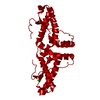 3hafC 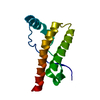 3hakC  3herC 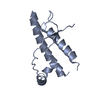 3hesC 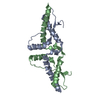 3hj5C  3hjxC C: citing same article ( |
|---|---|
| Similar structure data |
- Links
Links
- Assembly
Assembly
| Deposited unit | 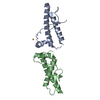
| ||||||||
|---|---|---|---|---|---|---|---|---|---|
| 1 | 
| ||||||||
| 2 | 
| ||||||||
| 3 | 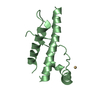
| ||||||||
| Unit cell |
|
- Components
Components
| #1: Protein | Mass: 16168.013 Da / Num. of mol.: 2 / Fragment: UNP residues 90-231 / Mutation: D178N Source method: isolated from a genetically manipulated source Source: (gene. exp.)   Homo sapiens (human) / Gene: PRNP, PRIP, PRP / Production host: Homo sapiens (human) / Gene: PRNP, PRIP, PRP / Production host:   Escherichia coli (E. coli) / References: UniProt: P04156 Escherichia coli (E. coli) / References: UniProt: P04156#2: Chemical | #3: Water | ChemComp-HOH / |  Water Water |
|---|
-Experimental details
-Experiment
| Experiment | Method:  X-RAY DIFFRACTION / Number of used crystals: 1 X-RAY DIFFRACTION / Number of used crystals: 1 |
|---|
- Sample preparation
Sample preparation
| Crystal | Density Matthews: 2.15 Å3/Da / Density % sol: 42.7 % |
|---|---|
Crystal grow | Temperature: 277 K / Method: vapor diffusion, sitting drop / pH: 8 Details: 0.1 M Tris, 0.2 M Mg acetate, 5% PEG4K, 5mM CdCl2, pH 8.0, VAPOR DIFFUSION, SITTING DROP, temperature 277K |
-Data collection
| Diffraction | Mean temperature: 100 K | |||||||||||||||||||||||||||||||||||||||||||||||||||||||
|---|---|---|---|---|---|---|---|---|---|---|---|---|---|---|---|---|---|---|---|---|---|---|---|---|---|---|---|---|---|---|---|---|---|---|---|---|---|---|---|---|---|---|---|---|---|---|---|---|---|---|---|---|---|---|---|---|
| Diffraction source | Source:  SYNCHROTRON / Site: SYNCHROTRON / Site:  NSLS NSLS  / Beamline: X25 / Wavelength: 1.1 Å / Beamline: X25 / Wavelength: 1.1 Å | |||||||||||||||||||||||||||||||||||||||||||||||||||||||
| Detector | Date: Mar 18, 2003 | |||||||||||||||||||||||||||||||||||||||||||||||||||||||
| Radiation | Protocol: SINGLE WAVELENGTH / Monochromatic (M) / Laue (L): M / Scattering type: x-ray | |||||||||||||||||||||||||||||||||||||||||||||||||||||||
| Radiation wavelength | Wavelength : 1.1 Å / Relative weight: 1 : 1.1 Å / Relative weight: 1 | |||||||||||||||||||||||||||||||||||||||||||||||||||||||
| Reflection | Resolution: 1.8→100 Å / Num. obs: 26006 / % possible obs: 95.8 % / Rmerge(I) obs: 0.052 / Χ2: 0.993 / Net I/σ(I): 36.939 | |||||||||||||||||||||||||||||||||||||||||||||||||||||||
| Reflection shell |
|
- Processing
Processing
| Software |
| |||||||||||||||||||||||||||||||||||||||||||||||||||||||||||||||||
|---|---|---|---|---|---|---|---|---|---|---|---|---|---|---|---|---|---|---|---|---|---|---|---|---|---|---|---|---|---|---|---|---|---|---|---|---|---|---|---|---|---|---|---|---|---|---|---|---|---|---|---|---|---|---|---|---|---|---|---|---|---|---|---|---|---|---|
| Refinement | Method to determine structure : :  SIR / Resolution: 1.8→40.12 Å / Cor.coef. Fo:Fc: 0.929 / Cor.coef. Fo:Fc free: 0.919 / Occupancy max: 1 / Occupancy min: 0.5 / SU B: 2.358 / SU ML: 0.075 / Cross valid method: THROUGHOUT / σ(F): 0 / ESU R: 0.13 / ESU R Free: 0.121 / Stereochemistry target values: MAXIMUM LIKELIHOOD SIR / Resolution: 1.8→40.12 Å / Cor.coef. Fo:Fc: 0.929 / Cor.coef. Fo:Fc free: 0.919 / Occupancy max: 1 / Occupancy min: 0.5 / SU B: 2.358 / SU ML: 0.075 / Cross valid method: THROUGHOUT / σ(F): 0 / ESU R: 0.13 / ESU R Free: 0.121 / Stereochemistry target values: MAXIMUM LIKELIHOODDetails: HYDROGENS HAVE BEEN ADDED IN THE RIDING POSITIONS U VALUES : REFINED INDIVIDUALLY
| |||||||||||||||||||||||||||||||||||||||||||||||||||||||||||||||||
| Solvent computation | Ion probe radii: 0.8 Å / Shrinkage radii: 0.8 Å / VDW probe radii: 1.4 Å / Solvent model: MASK | |||||||||||||||||||||||||||||||||||||||||||||||||||||||||||||||||
| Displacement parameters | Biso max: 74.32 Å2 / Biso mean: 26.635 Å2 / Biso min: 9.51 Å2
| |||||||||||||||||||||||||||||||||||||||||||||||||||||||||||||||||
| Refinement step | Cycle: LAST / Resolution: 1.8→40.12 Å
| |||||||||||||||||||||||||||||||||||||||||||||||||||||||||||||||||
| Refine LS restraints |
| |||||||||||||||||||||||||||||||||||||||||||||||||||||||||||||||||
| LS refinement shell | Resolution: 1.801→1.848 Å / Total num. of bins used: 20
|
 Movie
Movie Controller
Controller





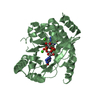



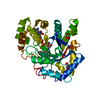



 PDBj
PDBj





